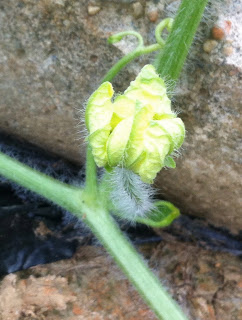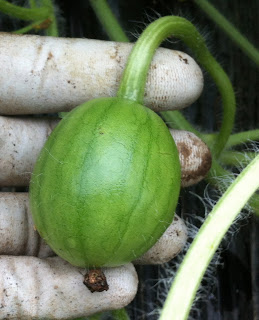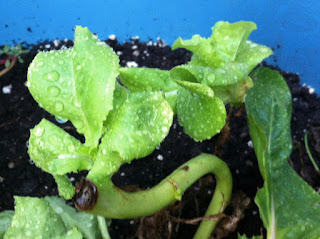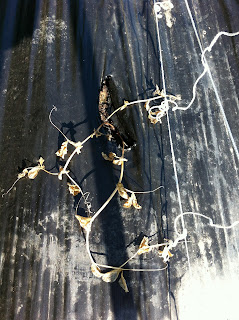I apologize for the lack of posts last week. It's been crazy busy around here.
I've been steadily collecting cherry and grape tomatoes, with one Sunbright thrown in. I'm thinking about doubling up on the cherries next year and skipping on the grapes. Cherries are sweeter and more full of flavor, while grapes are more like tiny plum or Roma tomatoes. Mine are least. Maybe because they are bigger than the grape tomatoes you buy in stores or at your local farmers' market.
The pickling cucumbers are going great. In fact, I put a bunch into the compost because I wasn't able to pickle them before they started going bad. Now I have the supplies, and about half of my current stock is sliced for making bread and butter pickles. Next will be the dills.
Now, my yellow squash has a story to tell. There is one plant in particular that is producing "conjoined squash." The fruits of this plant grow with two connected to each other, or a seam where two could be joined together. When I tried to pick one of these oddities, they broke apart. The larger one, came off in my hand and the smaller stayed with the plant. This proved that they have separate stems. I guess the smaller one will grow now that the big one is gone. Time will tell.
My small gourds are thriving. The bigger ones have huge plants, but I haven't been able to pollinate any female flowers yet. I've missed a couple due to the incessant rain we had for three or four days. I couldn't get out to the garden because it was so wet. When I finally made it out, there weren't no female flowers to be seen on any of the plants. There were small ones that will be ready in a couple days, but none ready for some love. I don't know if the rain stunted the growth of the females, but it almost seems that way.
I'm sorry for the lack of pictures here, but Blogger isn't letting me load photos. I'll post them when I can get it to work.
Tales of the dance--and stumbles--through life on our tiny homestead as we grow in our knowledge of our deepest roots and budding passions.
Tuesday, July 24, 2012
Thursday, July 12, 2012
Harvesting. . .
Every day, when I check on the garden, it is buzzing with activity. Literally. I have the big bumble bees (they're actually carpenter bees) that love my Rose of Sharon bushes and smaller honey bees buzzing from flower to flower. They all seem to like the big orange flowers produced by the cucumbers and squash, including the pumpkins.
I've been getting grape and cherry tomatoes randomly for a couple weeks now, but my first real harvest was a surprise. Pickling cucumbers and squash I had checked on two days previously were now huge. That first harvest yielded two yellow squash, four zucchinis, and an astounding thirteen pickling cucumbers. Two days later I got six more yellow squash, two more zucchinis, and one cucumber.
In the sweltering heat and humidity that defines summer here in the Chesapeake Bay state, I trudged out to the garden, dragging the heavy hose behind me. Two fifty-foot hoses together will only reach the first tomato plants in the two rows where they reside, so I fill the watering can and laboriously weave back and forth through the jungle that my garden is becoming.
While I was out there that Sunday evening, I checked for everything from pests to flowers to fruits. My efforts were rewarded with several discoveries. I found another large hornworm amidst some significant damage. I also noticed that those little devastators we call cucumber beetles are out, too. I realize these are not positive findings, but I've got some good news too.
The first flower I saw on the watermelons was a prize. . .
. . .but not as exciting as this. . .
By the time you read this, this little watermelon will have doubled in size. And several more are starting, too.
The first gourd flowers graced my garden that same evening. Gourd flowers only open at night, and only for one night. I will most definitely devote an entire entry to these magnificent, if slightly high maintenance, plants. They deserve the attention.
Those tiny, Autumnal joys that are Jack-B-Little pumpkins (actually gourds) are thriving at the top of the garden. For such small fruits, they have huge orange flowers much like other pumpkins and squash. I delighted to see the first one plumping up below its birthing flower.
On the deck, I was please to see that my "cut and come again" mesclun lettuce is truly that. Where I have cut older heads off, the tips have blackened and new leaves are sprouting just below. The green ice lettuce needs to be planted again.
The first flower I saw on the watermelons was a prize. . .
.jpg) |
| First watermelon flower I saw. |
. . .but not as exciting as this. . .
.jpg) |
| First Watermelon |
The first gourd flowers graced my garden that same evening. Gourd flowers only open at night, and only for one night. I will most definitely devote an entire entry to these magnificent, if slightly high maintenance, plants. They deserve the attention.
| First Gourd Flowers |
 |
| First Jack-B-Little |
.jpg) |
| Mesclun Coming Back |
Monday, July 9, 2012
Lessons & Surprises. . .
I really need to get the fence up. I've been lucky to this point, but a tour of the garden Friday morning revealed the first signs of deer damage. They'll only nibble on the outer-most plants because of the plastic, and they seem to stick to the "big" tomato plants instead of the cherries and grapes; however, they can still do damage. The one that got my Brandywine plant took scraping nibbles out of several of the fruits along with topping the plant.
| Tomato Hornworm |
.jpg) |
| Hornworm Damage Notice the stripped stems on the top half. |
 |
| What's left of my peas |
I found out that peas should be planted while the weather is still cold. Like March-cold. The plants are very tender and sensitive to the heat. My pea plants give testimonial to the fact that, if planted too late, they will not survive the summer heat. Apparently the pea harvest was ending as my plants were pushing through the surface. While I am upset and dishearten by this loss, I did learn a valuable lesson: plant the peas when I plant the onions early next spring.
On a more positive note, some of my gourds surprised me. The first was the large Martins planted in the garden. I planted five, which was half of my seed pack. When they started growing, I had three. I was happy with that. I don't expect every seed pushed into the soil to sprout and be productive, and if last year's harvest is any indication, these gourds promise to be big. I also have Tobacco Box gourds, which should be a good size, too. So I was happy with three large Martins. But then, while my three plants were growing longer stems and bigger leaves, another one popped up! The last one is much smaller than the rest, but I'm happy to have four.
.jpg) |
| Youngest Large Martin Gourd |
The best surprise I've gotten, though is a big one--figuratively speaking. Let me start by explaining that I planted seeds from two carved gourds. This may not seem like a big deal, but Meadowbrooke Gourds seemed pretty adamant that seed from these gourds would not grow. I gave it a shot anyway because the two gourds I collected seeds from are cute little things, and one holds a special place in my heart. The first one was sent to me as a spring promotion, and is a small Martin with a tulip carved into it. I designed the face carved on the second little one to look like Bug when he was just a pip-squeak with three teeth. (It was Fall open house at Meadowbrooke.)
To date none of the seeds planted from the tulip have sprouted. I only got two seeds from what I affectionately call the "Bug gourd." I planted them both in a large pot by the deck. Even after the germination time had passed, I watered the soil in the pot and pulled the weedy grasses that were sprouting. I didn't think they would grow after what Meadowbrooke had said and the fact that the tulip gourd seeds were doing nothing.
But one day, there it was. A small little gourd plant had sprouted over a one or two day time. Surprise and elation flooded me. This was the one, very special gourd that I had so wanted to grow, and here it was!
| The Bug gourd & its "baby." |
The little plant is thriving and loving the heat wave we've been having here in the mid-atlantic.
Monday, July 2, 2012
The Good, the Bad, & the Eaters. . .
Insects and other wildlife can be a wonder to watch as they roam and flutter about my realm. At the same time I know that the beauty of a butterfly also means the destruction from it's larva. And the peaceful meanderings of deer comes with the possible loss of crops to their greedy little muzzles.
Still, as long as the damage from the caterpillars isn't extensive, and as long as the deer stay out of my garden, I enjoy being able to appreciate the charm of my local wildlife. So here are a few pictures I snapped while out and about in my yard.
| This was the first "real" butterfly I saw on my butterfly bush. His wings were a bit torn, but he was still handsome. |
| I saw this lovely yellow swallowtail offering up such a beautiful contrast on the deep purple of the flowers. |
.jpg) |
| They are incredible to watch, & have such personality. |
One of my favorite bugs to see in the garden is a Praying Mantis. These freaky-looking helpers are crawling everywhere in my garden. I've seen several in my herbs and out front, and I saw one in my raspberry bush while I was picking the other day. There must be a nest somewhere within the gardens around the house because there are so many, ranging from less than an inch to almost three inches long. That means that buggy pests of all sizes are being chowed down.
.jpg) |
| This is the little guy I rescued from inside my house. |
| Bee in a Rose of Sharon flower. |
| Doe to the right of the rusty burn barrel. |
These aren't the best pictures, but we had two deer--one a buck--in our yard a couple weeks ago. As we watched three more deer crossed the field behind our fruit trees, and the deer in our yard joined them. That was decidedly good for them because I was poised to chase them off should they have gotten too close to my garden. (I should note, however, that the plastic liner in the garden seems to be a good deterrent for the deer.)
| "Our" two deer joining the three in the back field. |
Now, for my favorite portion of my critter entry. . . Can you tell what this is?
The same night we saw the deer, and I chased a cat out of my veggie garden with a hose, and I saw two different Praying Mantises in my herbs, we saw a toad sitting at the top of the deck stairs. This also happened to be the day I researched toad houses and toads in general, learning that toads can eat hundreds of bug each night. (I knew they ate bugs, but I had no idea they were so efficient.) Because of all I had learned, I let him stay up on the deck to eat to his heart's content.
The next morning I saw that something had been digging in my silver-tipped thyme. In checking to make sure it wasn't from a cat, I found this. . .
Subscribe to:
Posts (Atom)
.jpg)